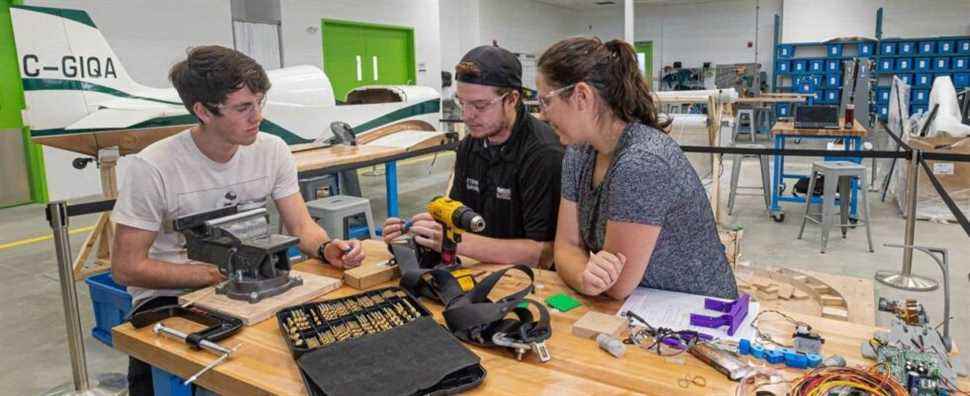This text is part of the special Philanthropy section
With its new brand image and its initiatives multiplied in recent years, the University of Sherbrooke wishes to become a driver of change by working with the community.
The most recent fundraising campaign for the Université de Sherbrooke Foundation ended in 2018. For the rector of the establishment, the operation may be over, but its philanthropic spinoffs can still be observed today. “All of these donations make a big difference,” says Pierre Cossette. In this way, the money raised has made it possible to create contexts for active learning, he explains.
“The RBC Center for University Expertise in Mental Health is a fine example of what a university can do in its community,” says Mr. Cossette. This establishment is stepping up initiatives, particularly in a partnership with Bishop’s University and the region’s CEGEPs. “We pooled resources to help young people with psychological health problems. Thus, we offer them all the same frame of reference, the same toolbox, ”he says.
The center is also a place for graduate and postgraduate research. “It is action research that leaves behind much more than a diploma”, underlines the rector, who adds that good practices continue to spread in the health sector.
Philanthropic donations to the University of Sherbrooke have also led to the creation of a unique partnership between the establishment and the CIUSSS de l’Estrie-CHUS to set up the Clinical Simulation Laboratory (LSC). It allows both employees of the health network and medical and nursing students to come together. They thus create multidisciplinary teams working together on complex situations. “There are clinical simulation labs in all medical schools. But for us, it is the same for the health establishment, the CIUSSS de l’Estrie-CHUS, and for the Faculty ”, summarizes the rector.
Philanthropic students
The philanthropic campaign that ended in 2018 gave birth to the creation studio in the name of the Huguette and Jean-Louis Fontaine Foundation, inaugurated in October 2019. This project which cost $ 11.2 million was funded at 75 % by donors. Students from the General Association of Engineering Students (AGEG) also helped out, contributing $ 1 million.
The initiative is making children since the studio will soon host the Siboire Factory-School, an NPO created in partnership with the microbrewery of the same name. A real “training laboratory” which will be inaugurated in 2022, underlines Mr. Cossette. The place will have the infrastructure to offer students in particular to do biotechnological engineering and chemical engineering. “It’s a great example of how philanthropy allows us to do things differently, both for students, but also for employees and faculty,” he adds.
Help entrepreneurs
While the first epidemiological wave led to a drop in economic activity in the country, entrepreneurship students at the university were still able to count on the Technology Business Accelerator (ACET). The National Bank also donated $ 2.4 million to it in 2018. “The team continued to support our young shoots to get through the crisis and get off to a new start,” says the rector.
ACET also enables interdisciplinary work between students in management and those from other faculties. This gives rise to practical projects such as the public health analysis of ventilation towers or the clean-up of beaches, illustrates Mr. Cossette. “But it’s not just to finance businesses,” he says. As a result, ACET emphasizes mentoring in order to help students move from the ideation phase to that of commercialization. “The accelerator helps young people to translate their dreams, their ideas, their intuitions, into something concrete,” he says.
The University also works with the City of Sherbrooke to meet the needs of the local community. Thus, the municipality undertakes to pay an amount of up to $ 6 million over ten years. This funding comes in the form of rebates on amounts in lieu of taxes generated by new construction on campus. This enabled the higher education institution to hire staff to bring together university experts and the public.
“Walking in an organization where there are 7,000 employees and 30,000 students, it’s quite complicated to find who can do what”, observes the rector. Thus, specialists from different fields lend a hand to local entrepreneurs from diverse sectors. “Sometimes it’s small SMEs that can’t afford research and development. With our business partnerships group, it creates a window for the community ”which facilitates the process, he explains.
A new unifying logo
In order to become a “brand of communities”, the University of Sherbrooke unveiled a brand new logo in October. “We want a brand universe that is much more flexible,” projects Mr. Cossette. Thus, the “UdS” logo replaces “UdeS” by decompartmentalizing the last letter.
Through this change, the university wishes not only to be able to adapt its symbol to digital platforms and social networks, but also to ensure that its partners can modify it in their image. “We take the“ S ”out of the box so that our community and our student associations can appropriate it,” explains the rector. “Sometimes it’s hard to see all of that in one little logo, but the idea is really to say ‘UdS is us’. “
